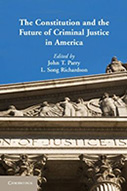The Constitution and the Future of Criminal Justice in America

Editors: John T. Parry and L. Song Richardson
Publisher: New York: Cambridge University Press, 2013. 352p.
Reviewer: Craig Hemmens | July 2014
The criminal justice system has undergone tremendous changes since the 1960s, when the civil rights movement and the activist Warren Court combined to push the criminal justice system to do a better job of treating citizens in accordance with their view of the Constitution. In the latter part of the twentieth century the criminal justice system struggled with issues such as an increasing violent crime rate, the so-called “war on drugs,” and the use of mass incarceration. The September 11, 2001 attacks caused terrorism to intersect with criminal justice.
Throughout the past fifty years the courts have been forced to deal with a host of issues—from coerced confessions and the expansion of the exclusionary rule in the 1960s to mandatory minimum sentences and the death penalty in the 1980s to the role of technology in law enforcement in the 2000s. The result has been a steady erosion of the constitutional rights of suspects, defendants, and inmates. Courts have made it easier for the police to investigate, for prosecutors to convict, and tougher for inmates to file appeals. As we enter the second decade of the twenty-first century, it remains an open question where the criminal justice system will go next.
The Constitution and the Future of Criminal Justice in America, edited by John T. Parry and L. Song Richardson, is comprised of seventeen chapters authored by leading legal scholars. Its genesis is in a conference, “The Constitution in 2020,” held at the Florida State University School of Law in 2010. This conference was related to Jack Balkin’s book of the same name, and this volume is a fine complement to that one. A number of well-regarded legal scholars contributed to the book, including Susan Bandes (DePaul University Law School), Stephen Bright (Southern Center for Human Rights), Richard Leo (University of San Francisco Law School), and Christopher Slobogin (Vanderbilt University School of Law).
The book is divided into seven sections. Each section addresses one area in constitutional criminal law and procedure. These include access to counsel, race and policing, privacy and police investigatory practices, the impact of technological developments on the criminal justice system, the reasonable expectation of privacy under the Fourth Amendment, confessions and the Miranda warnings, sentencing, and the impact of the war on terror on the criminal justice system and the Constitution. These topics run the gamut of the “hot button” issues of the day in criminal justice and the law. Rather than examine all seventeen chapters in this review, something which space does not permit, I will discuss the sections generally.
Section One covers issues associated with the right to counsel. A key problem with the right to counsel for indigent defendants is obtaining not merely counsel, but meaningful access to counsel. Public defenders offices and other attorneys who provide representation for indigent defendants are often overworked and under-resourced. They are often unable to conduct a thorough investigation and provide informed advocacy. The result is a diminution of the adversarial role and a reliance on case processing rather than a rigorous examination of the state’s case. As most criminal defendants are unable to afford retained counsel, it is essential that they be provided with meaningful access to counsel if the criminal justice system is to be able to retain its adversarial nature. The chapters in this section complement other recent writing on these issues (see, e.g., Houppert, 2013).
Section Two examines the intersection of race and policing. The war on drugs and the police use of profiling have led to charges of racism, as minorities are disproportionately overrepresented in both drug arrests and traffic stops. The Supreme Court decision in Terry v. Ohio (1968), which was hailed at the time as imposing a needed limit on police discretion, has been turned on its head by subsequent Supreme Court decisions which have authorized invasive police tactics in the service of so-called “quality of life” policing (see, e.g., Vitale, 2009).
Section Three examines recent Supreme Court decisions authorizing police to aggressively pursue consent to search in the absence of probable cause or even reasonable suspicion. These decisions ignore the power imbalance inherent in police-citizen encounters and greatly weaken the protections of the Fourth Amendment (Stuntz, 2011). They are yet another example of how police take every opportunity to “push the envelope” on what the law allows, and how the courts so often are complicit in this pushing the law to the advantage of the police.
Section Five focuses on the increasing reliance on technology and the move toward what has been called the “surveillance society.” Police now routinely use technological aids such as GPS technology, cell phone technology, and heat detection technology to monitor offenders and to investigate criminal activity. These technologies have a significant potential impact on citizens’ reasonable expectation of privacy, an issue discussed in several recent works (see. e.g., Schulhofer, 2012).
Section Six reviews the law regarding Miranda warnings and the incidence of false confessions. Others have also written on these topics recently (Warden and Drizin, 2009), and brought to life troubling data indicating false confessions occur far more frequently than police and prosecutors have acknowledged (Garrett, 2011).
Section Seven examines some of the collateral consequences of a criminal conviction. This is an important topic, as the drug war has led to mass incarceration over the past quarter century. The result has extended beyond prison walls, and led to a move to disenfranchise felons, a movement often linked to political motivation (Clear, 2003).
Section Nine focuses on the war on terror and the criminal justice system. There has been a trend towards greater reliance on military detention and military commissions rather than the criminal justice system and criminal trials for terrorist suspects. As the amount of transnational law enforcement activity has increased, there has been an increase in executive power and a reduction in the role of the criminal court system.
The Constitution and the Future of Criminal Justice in America, like most edited books, has its gaps and its highs and lows. Taken as a whole, however, the book is essential reading for persons who want to increase their understanding of contemporary constitutional criminal procedure law. The book is heavy on legal doctrine rather than empirical social science, but understanding these doctrines and the trends in the law, are crucial to gaining a full understanding of how law impacts the criminal justice system—in policy, procedure, and practice.
References
Balkin, Jack M., and Reva B. Siegel. 2009. The Constitution in 2020. New York: Oxford University Press.
Clear, Todd. 2003. Invisible Punishment: The Collateral Consequences of Mass Imprisonment. New York: The New Press.
Garrett, Brandon L. 2011. Convicting the Innocent: Where Criminal Prosecutions Go Wrong. Cambridge, MA: Harvard University Press.
Houppert, Karen. 2013. Chasing Gideon: The Elusive Quest For Poor People’s Justice. New York: The New Press.
Miranda v. Arizona, 384 U.S. 436 (1966).
Schulhofer, Stephen J. 2012. More Essential Than Ever: The Fourth Amendment in the Twenty-first Century. New York: Oxford University Press.
Stuntz, William J. 2011. The Collapse of American Criminal Justice. Boston, MA: Harvard University Press.
Terry v. Ohio, 392 U.S. 1 (1968).
Vitale, Alex S. 2009. City of Disorder: How the Quality of Life Campaign Transformed New York Politics. New York: New York University Press.
Warden, Rob, and Steven A. Drizin. 2009. True Stories of False Confession. Chicago, IL: Northwestern University Press.
Craig Hemmens is Professor in the Department of Criminal Justice and Criminology at Washington State University.


